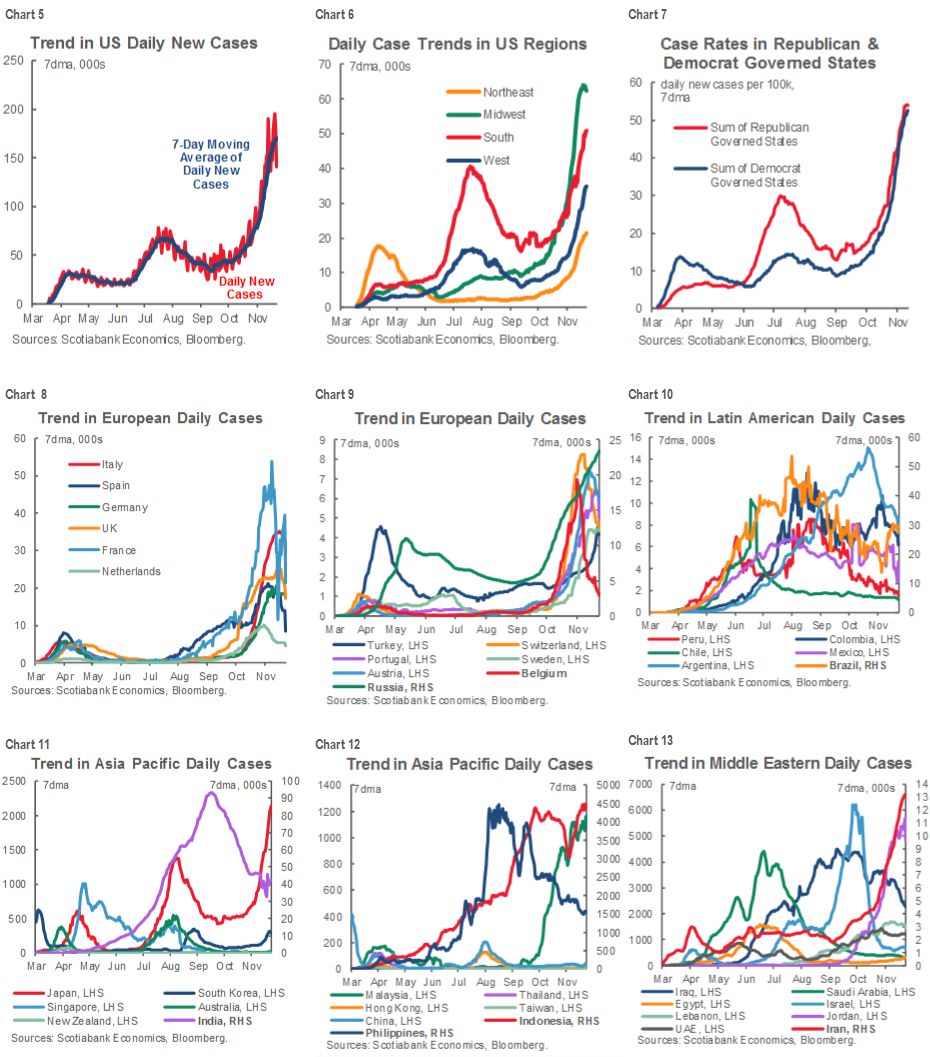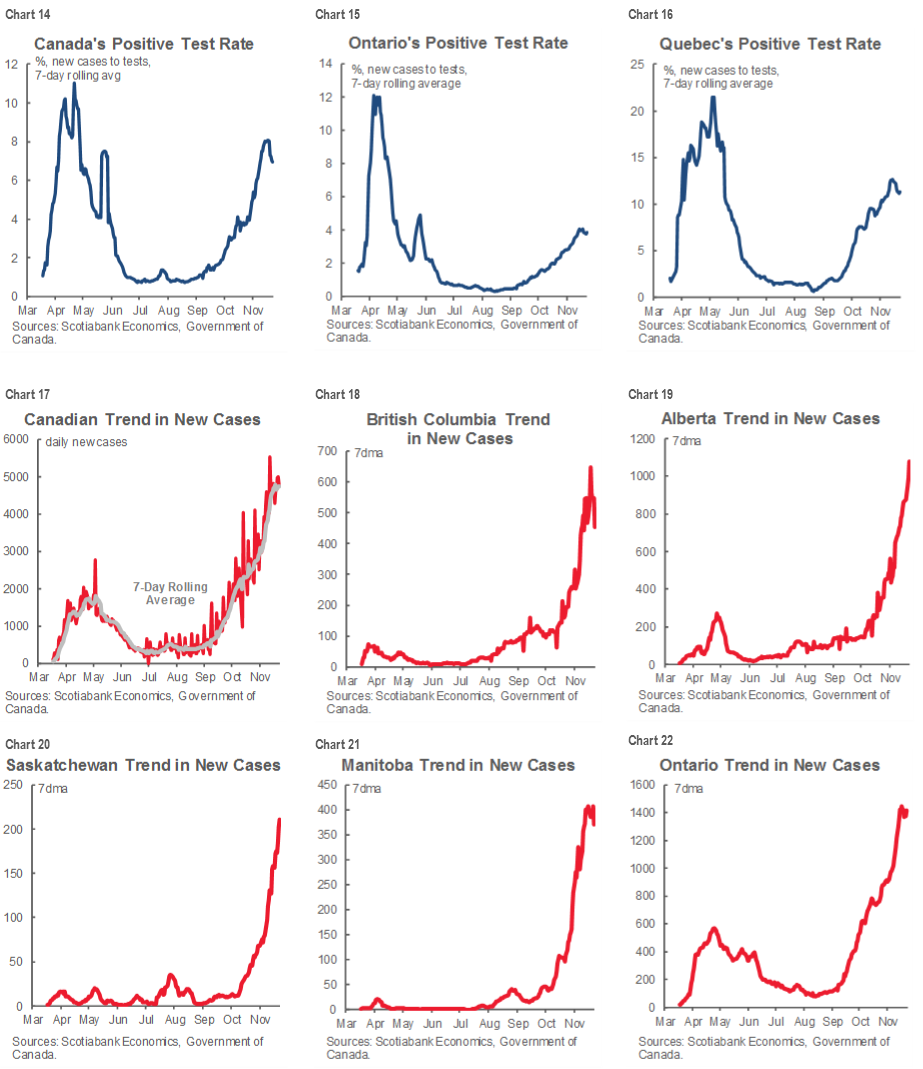ON DECK FOR MONDAY, NOVEMBER 23

KEY POINTS:
- Risk-on to start the week
- US, Australian PMIs move higher…
- …as Eurozone & UK PMIs point to double dip
- Is the wave 1 PMI playbook repeating?
- Global covid-19 in charts: US, Canada continue to see upswings…
- …against progress in Europe, Latin America…
- …and mixed trends across Asia-Pacific
- BoC to speak on financial stability
INTERNATIONAL
The week is off to a solid risk-on start despite poor macro data that merely confirms near-term downside risk to European economies. Stocks are continuing to look through to the post-lockdown vaccine-driven environment. Brexit headlines offer the same old same old (close, but far, still working….). I can’t think AstraZeneca’s vaccine really matters to markets at this point even notwithstanding mixed headlines on efficacy, after markets have already digested what appear to be stronger results from Moderna and Pfizer.
- The US S&P500 is bouncing within gains of ¼% to ½% so far this morning. The TSX is up ¼%. European cash markets are up by around ¼% except for London that is off by ¼%. Asia-Pacific markets rallied but Japan was shut for Labour Thanksgiving Day.
- US Ts are bear steepening with 10s and 30s up by 3bps. Canada’s curve is performing similarly. The gilts curve is shifting upward by 2bps across maturities. EGB 10s are mixed but generally little changed with mild cheapening on average.
- The USD had been depreciating earlier in the morning but is now down against most major crosses except CAD and the Mexican peso with oil up by a few dimes.
The eurozone composite PMI fell by almost five points to 45.1 to signal renewed contraction in the Eurozone economy. Services were particularly hard hit with a decline in that PMI of over five points to 41.3 while manufacturing dipped 1.2 points to 53.6 to stay in slower expansion. Thus far, the gentle downside to PMIs is a far cry from earlier in the year but is expected to moderately worsen and drag GDP growth down (chart 2).

Across the Eurozone, France’s nationwide lockdown resulted in a worse deceleration than in Germany. France’s composite PMI fell by 7.6 points to 39.9 to return to a pace of contraction similar to during May, while Germany’s fell by three points to 52 which indicates slower expansion.
The UK composite PMI fell by almost five points to 47.4 as services slipped into renewed recession (45.8, 51.5 prior) while manufacturing accelerated (55.2, prior 53.7). Chart 3 shows the rolling PMIs correlated with GDP growth.

Australia’s PMIs bounced back in November partly on reopening effects in Victoria. The composite PMI increased 1.2 points to 54.7 to signal faster GDP growth. The gain was split between the manufacturing and services PMIs. This may be a transitory gain as downside risk to global growth catch up to Australia. Chart 4 shows PMIs holding up better so far as a GDP indicator.

Global covid-19 cases continue to soar. The weekly update of case trends is provided in charts 5–27. US cases continue to climb across all regions and it doesn’t matter if we’re talking blue or red states. Within Europe, France’s lockdown had been driving cases sharply lower, but this has since reversed again as a caution against lockdown cure-alls. Other parts of Europe may be witnessing improving trends outside of Russia and Turkey, but it remains premature to assess. Aside from Brazil, multiple parts across Latin America are also seeing waning trends for new cases. Within Asia-Pacific markets the evidence is mixed as cases rise in Japan, South Korea, Indonesia and Malaysia while they fall in India and the Philippines and remain low in Australia.



UNITED STATES
The composite US Markit PMI increased by 1.6 points to 57.9. Being further above 50 that signals an accelerating expansion in GDP growth. The gain was driven by both services and manufacturing. As chart 1 shows, the US PMI supports Q4 GDP growth expectations. They are less widely watched than ISM and Markit’s PMIs always attract a much thinner and largely irrelevant consensus. ISM is a purer gauge of the US economy by considering only domestic operations so the Fed watches that one more closely.

Fed-speak will include Richmond’s Barkin (12:30pmET), San Fran’s Daly (1pmET) and Chicago’s Evans (3pmET).
CANADA
Bank of Canada Deputy Governor Gravelle gives a speech on the impact of covid-19 on financial stability (2pmET) which offers low market risk.
Provincial covid-19 case charts are also updated in the accompanying collection. Canadian cases remain trending around a record with no clear signs of topping anywhere. The so-called Atlantic bubble is being somewhat pierced as evidenced by climbing case counts in New Brunswick alongside only muted increases in Nova Scotia and Newfoundland & Labrador and essentially none in PEI. Also note that positive test rates continue to rise nationwide toward levels seen during wave 1, albeit with the usual caution that comparing across time is complicated by differing samples.

DISCLAIMER
This report has been prepared by Scotiabank Economics as a resource for the clients of Scotiabank. Opinions, estimates and projections contained herein are our own as of the date hereof and are subject to change without notice. The information and opinions contained herein have been compiled or arrived at from sources believed reliable but no representation or warranty, express or implied, is made as to their accuracy or completeness. Neither Scotiabank nor any of its officers, directors, partners, employees or affiliates accepts any liability whatsoever for any direct or consequential loss arising from any use of this report or its contents.
These reports are provided to you for informational purposes only. This report is not, and is not constructed as, an offer to sell or solicitation of any offer to buy any financial instrument, nor shall this report be construed as an opinion as to whether you should enter into any swap or trading strategy involving a swap or any other transaction. The information contained in this report is not intended to be, and does not constitute, a recommendation of a swap or trading strategy involving a swap within the meaning of U.S. Commodity Futures Trading Commission Regulation 23.434 and Appendix A thereto. This material is not intended to be individually tailored to your needs or characteristics and should not be viewed as a “call to action” or suggestion that you enter into a swap or trading strategy involving a swap or any other transaction. Scotiabank may engage in transactions in a manner inconsistent with the views discussed this report and may have positions, or be in the process of acquiring or disposing of positions, referred to in this report.
Scotiabank, its affiliates and any of their respective officers, directors and employees may from time to time take positions in currencies, act as managers, co-managers or underwriters of a public offering or act as principals or agents, deal in, own or act as market makers or advisors, brokers or commercial and/or investment bankers in relation to securities or related derivatives. As a result of these actions, Scotiabank may receive remuneration. All Scotiabank products and services are subject to the terms of applicable agreements and local regulations. Officers, directors and employees of Scotiabank and its affiliates may serve as directors of corporations.
Any securities discussed in this report may not be suitable for all investors. Scotiabank recommends that investors independently evaluate any issuer and security discussed in this report, and consult with any advisors they deem necessary prior to making any investment.
This report and all information, opinions and conclusions contained in it are protected by copyright. This information may not be reproduced without the prior express written consent of Scotiabank.
™ Trademark of The Bank of Nova Scotia. Used under license, where applicable.
Scotiabank, together with “Global Banking and Markets”, is a marketing name for the global corporate and investment banking and capital markets businesses of The Bank of Nova Scotia and certain of its affiliates in the countries where they operate, including; Scotiabank Europe plc; Scotiabank (Ireland) Designated Activity Company; Scotiabank Inverlat S.A., Institución de Banca Múltiple, Grupo Financiero Scotiabank Inverlat, Scotia Inverlat Casa de Bolsa, S.A. de C.V., Grupo Financiero Scotiabank Inverlat, Scotia Inverlat Derivados S.A. de C.V. – all members of the Scotiabank group and authorized users of the Scotiabank mark. The Bank of Nova Scotia is incorporated in Canada with limited liability and is authorised and regulated by the Office of the Superintendent of Financial Institutions Canada. The Bank of Nova Scotia is authorized by the UK Prudential Regulation Authority and is subject to regulation by the UK Financial Conduct Authority and limited regulation by the UK Prudential Regulation Authority. Details about the extent of The Bank of Nova Scotia's regulation by the UK Prudential Regulation Authority are available from us on request. Scotiabank Europe plc is authorized by the UK Prudential Regulation Authority and regulated by the UK Financial Conduct Authority and the UK Prudential Regulation Authority.
Scotiabank Inverlat, S.A., Scotia Inverlat Casa de Bolsa, S.A. de C.V, Grupo Financiero Scotiabank Inverlat, and Scotia Inverlat Derivados, S.A. de C.V., are each authorized and regulated by the Mexican financial authorities.
Not all products and services are offered in all jurisdictions. Services described are available in jurisdictions where permitted by law.

